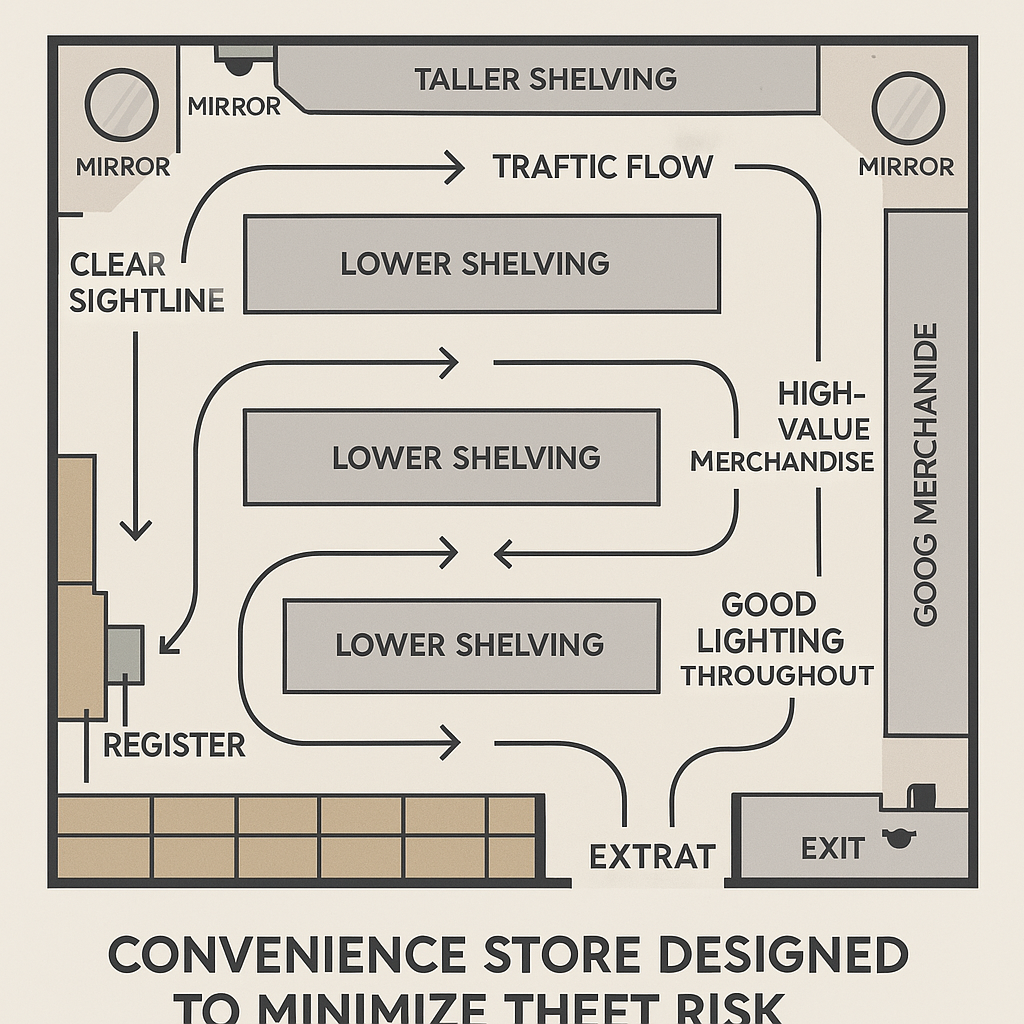Strategic Store Design: Creating Layouts That Minimize Theft Risk
The young man enters your store, eyes darting across the aisles. He wanders toward the back corner, where tall shelving creates a perfect blind spot. Within moments, he slips several items into his jacket and walks out.

The young man enters your store, eyes darting quickly across the aisles. He wanders toward the back corner, where tall shelving creates a perfect blind spot – completely hidden from your register view and security cameras. Within moments, he slips several items into his jacket and casually walks out, never making a purchase. Your store layout just facilitated a theft that could have been prevented through thoughtful design choices.
Every convenience store faces theft challenges, but your physical layout serves as your first line of defense. Strategic design decisions can dramatically reduce opportunity, increase risk for potential thieves, and create an environment where staff maintain natural visual control – all while preserving a positive shopping experience for honest customers.
The Power of Purposeful Layout
Your store's physical arrangement directly influences theft patterns. Stores with poor visibility, cluttered spaces, and confusing traffic flow experience significantly higher theft rates than locations designed with security awareness. The most effective designs balance merchandising needs with loss prevention principles.
When employees can maintain visual contact across the entire store, potential thieves lose the cover they need to operate. When merchandise flow creates natural customer pathways, unusual movement patterns become immediately apparent. When high-value items receive special placement consideration, they remain both accessible and protected.
Creating Clear Sightlines
The foundation of theft-deterrent design starts with visibility:
Position your register to maximize forward viewing angles across the store floor. The ideal setup allows staff to see the entire shopping area while processing transactions.
Keep display heights varied, with taller fixtures against walls and shorter units in central areas. This creates a "stadium seating" effect where visibility extends across the entire space.
Avoid creating dead zones – areas completely hidden from staff view. Corner areas particularly require attention, as they often become theft hotspots when neglected.
Consider angled shelving in problem areas to improve visibility while still maximizing merchandising space.
Use mirrors strategically to extend sightlines around corners and into areas that would otherwise remain hidden from view.
Strategic Product Placement
The items you place in different store zones significantly impact theft patterns:
Position high-value, high-theft items within clear view of the register area. Items like razors, medicine, energy supplements, and premium alcohol benefit from this visible protection.
Move smaller, easily pocketed items away from store exits and into areas with consistent staff presence.
Create open space around frequently stolen merchandise. Thieves prefer crowded areas where their actions blend with normal shopping movements.
Consider using locked cases or closed cabinets for the most frequently stolen items, but maintain reasonable accessibility for legitimate customers.
Place impulse items near the register, where they receive constant supervision while also driving additional sales.
Traffic Flow That Supports Security
How customers move through your store affects both sales and security:
Design main aisles to guide customers past the register area at multiple points during their shopping journey. This creates natural opportunities for staff-customer interaction.
Position checkout areas to ensure customers must pass by staff when exiting, creating a psychological deterrent for potential thieves.
Eliminate "straight shot" paths from entrance to exit that allow people to move through without engaging with the store layout or staff.
Ensure aisles remain wide enough for comfortable shopping but are arranged to prevent quick grab-and-run scenarios.
Create natural "bottlenecks" near exits that slow customer movement without causing inconvenience.
Lighting and Visibility
Thoughtful lighting complements your layout strategy:
Maintain consistent, bright lighting throughout all shopping areas. Shadow zones invite problematic behavior.
Pay special attention to lighting at entrances, exits, and around high-value merchandise displays.
Position overhead lighting to minimize shadows created by shelving units and displays.
Consider targeted lighting for specific high-risk or high-value merchandise sections.
Ensure parking areas and store exteriors receive adequate lighting to extend your security zone beyond the doors.
Staff Positioning and Awareness
Even the best layout requires proper staff utilization:
Position employees throughout the store during busy periods rather than clustering them in one area.
Create work tasks that naturally move staff through different store zones throughout their shifts.
Train employees to maintain awareness while performing routine tasks like restocking or cleaning.
Develop specific procedures for monitoring high-risk areas when staffing becomes limited.
Technological Integration
Modern technology works alongside your physical layout:
Position security cameras to cover areas where natural staff visibility might be limited.
Use visible security monitors that show customers they're on camera while shopping.
Consider height strips at entrances that psychologically remind potential thieves that physical characteristics are being noticed.
The most effective loss prevention strategies combine environmental design, staff awareness, and supporting technologies. Your store layout creates the foundation for all other security measures.
As you look around your convenience store today, which areas currently provide perfect cover for potential theft, and what simple changes could transform these vulnerabilities into secure, productive selling spaces?